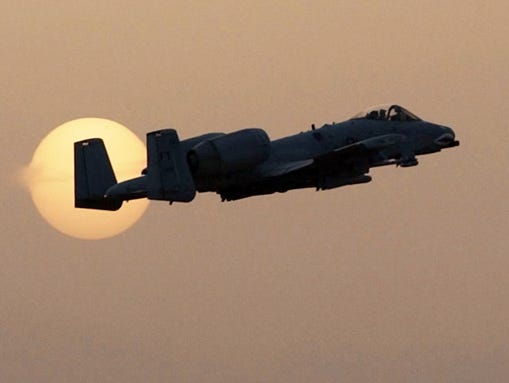THE GOOD NEWS—WHERE ‘FRIENDLY FIRE’ IS CONCERNED (IF YOU CAN BELIEVE THE OFFICIAL FIGURES) IS THAT
CASUALTIES FROM FRIENDLY FIRE ARE EXCEEDINGLY RARE
SINCE 2001, 140,000 MISSIONS—45 FRIENDLY FIRE INCIDENTS

I’m not going to comment on the official figures except to say that it is wise to regard all such figures—whether issued by government, corporate, academic, or religious, institutions—with considerable skepticism.
Here, I am not being cynical, but am merely being guided by the track record. That said, as best as I can judge, friendly fire resulting from misguided CAS is very much the exception.
The Air Force is continuing to try and eliminate the A-10 despite its impressive track record as a highly survivable and effective CAS (Close Air Support) aircraft. The aircraft does have some limitations.
- It’s old. First flight was in 1972
- It’s slow. The issue here is that it takes time to get to the fight. Being slow during the fight—given that it allows the pilot to see and understand the ground conflicts—is an advantage. The Air Force like to say, “Speed is life.” Where CAS is concerned, you can also argue, “Speed is ignorance.”
- It’s arguably underpowered (new engines could resolve that issue)..
- It is essentially a single purpose aircraft. It is optimized for CAS—and that is pretty much it.
On the other side of the list, the A-10 has so many advantages that it would take a book to list them—and it is clear that if the Air Force leaders were really committed to CAS, they would focus more on upgrading the A-10, or developing an updated version, than scrapping the most effective CAS aircraft yet built.
The following is an extract from a USA Today story.
Since 2001, the A-10 has been involved in four friendly fire incidents that killed 10 U.S. troops. The next highest is the B-1B bomber, which killed five soldiers last year in one incident. Friendly fire deaths are exceptionally rare. There have been 45 total friendly fire incidents out of about 140,000 missions flown by the Air Force, Navy and Marines.
Air Force One departs past a squadron of Fairchild Republic A-10 Thunderbolt II (Warthog) jets at Gowen Field in Boise, Idaho, on Jan. 21. (Photo: Stan Brewster, AP)
The A-10 is the aircraft responsible for the most civilian deaths in Afghanistan since 2010, when data on those deaths started to be collected. Thirty-five people have been killed compared with 19 killed by the Harrier, data show.
In close-air-support missions in which weapons were dropped in Afghanistan, the A-10 has a slightly lower percentage of civilian casualty incidents per missions flown than B-1 bombers or F-16 fighters. More than 99% of the missions in which warplanes attack enemy ground fighters avoid harm to U.S. troops or civilians.
VOR words c.200

No comments:
Post a Comment